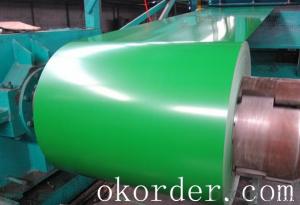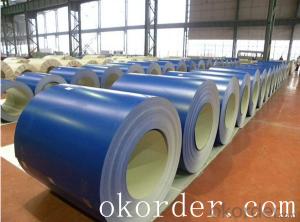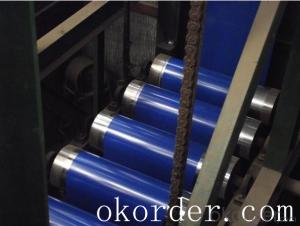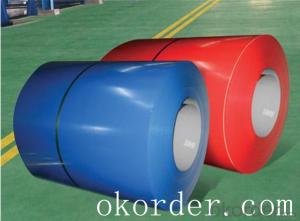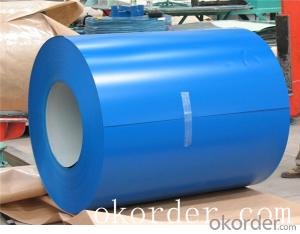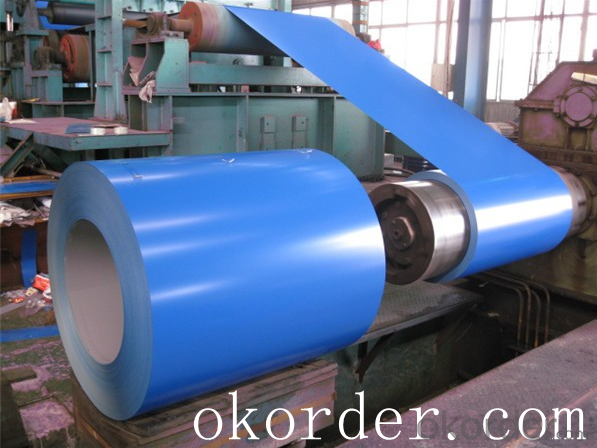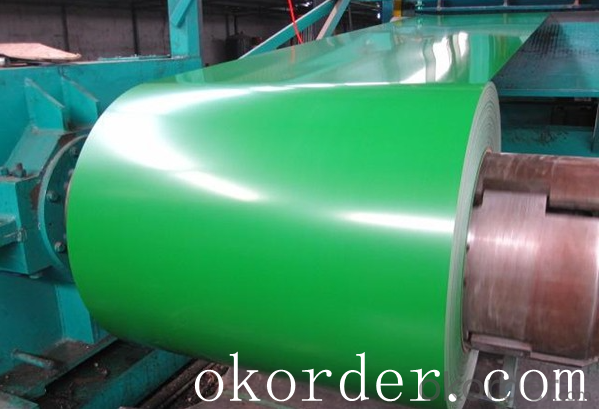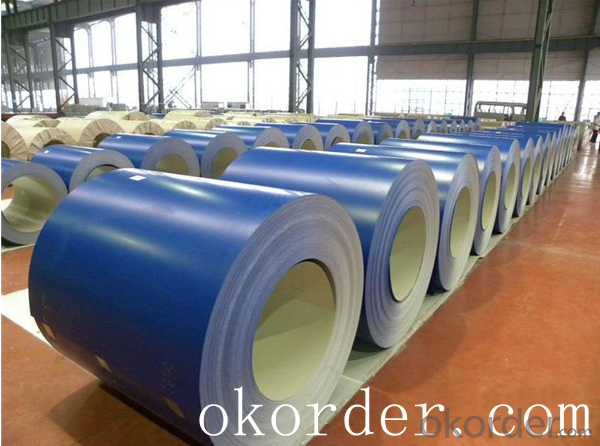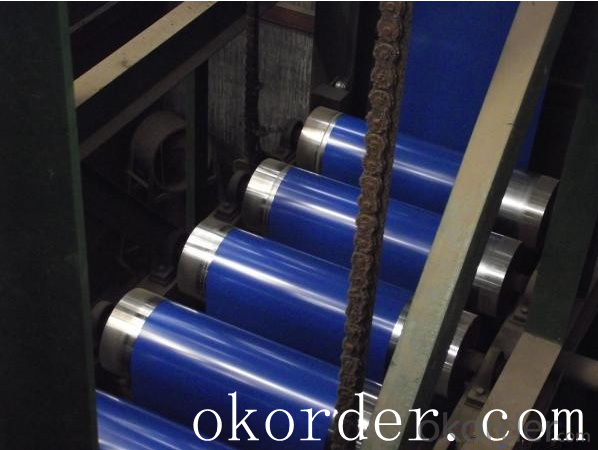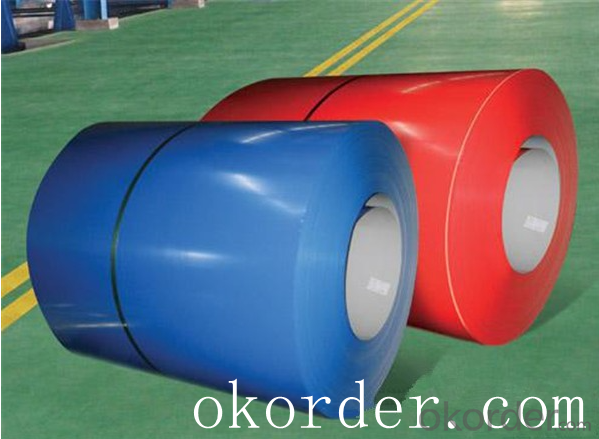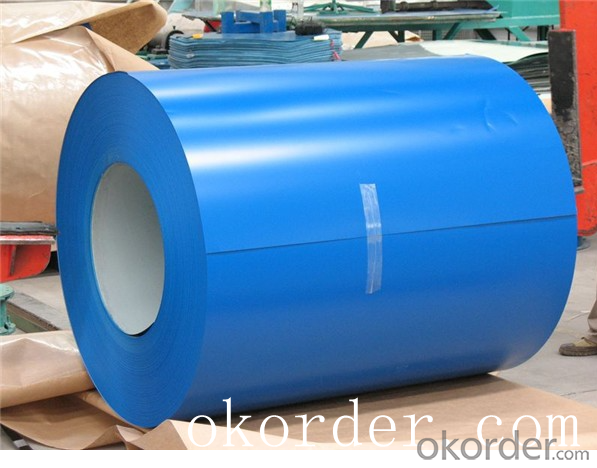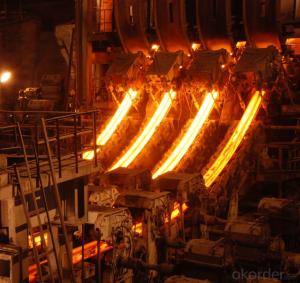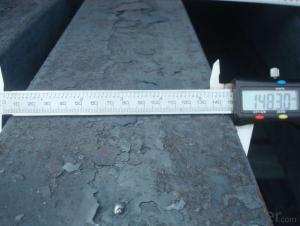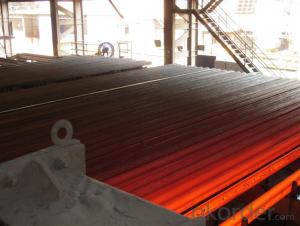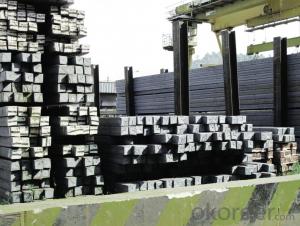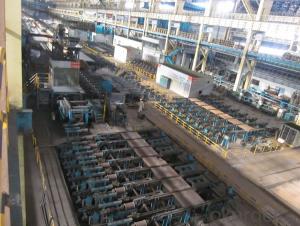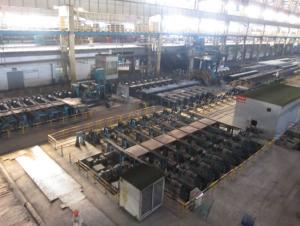Prime quality prepainted galvanized steel 635mm
- Loading Port:
- Tianjin
- Payment Terms:
- TT OR LC
- Min Order Qty:
- 100 m.t.
- Supply Capability:
- 10000 m.t./month
OKorder Service Pledge
OKorder Financial Service
You Might Also Like
Construction building material galvanized color prepainted cold
rolled steel coil
Prepainted steel sheet is coated with organic layer, which provides higher anti-corrosion property and
a longer lifespan than that of galvanized steel sheets.
The base metals for prepainted steel sheet consist of cold-rolled, HDG electro-galvanized and hot-dip
Alu-zinc coated. The finish coats of prepainted steel sheets can be classified into groups as follows:
polyester, silicon modified polyesters, polyvinylidene fluoride, high-durability polyester, etc
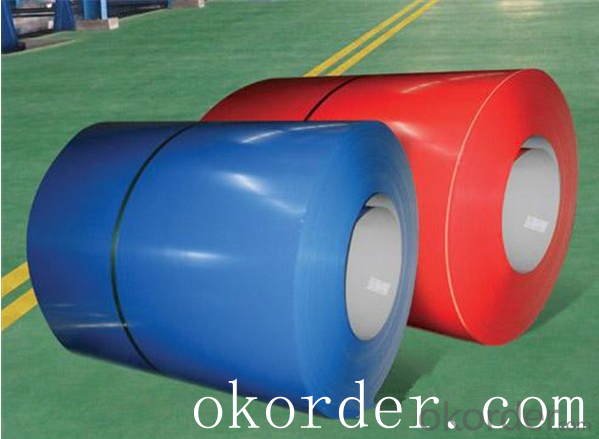
Standard and Grade :
Pre-paint galvanized steel coil | ||||
ASTM A755M-03 | EN10169:2006 | JISG 3312-2012 | ||
Commercial quality | CS | DX51D+Z | CGCC | |
Structure steel | SS GRADE 230 | S220GD+Z | CGC340 | |
SS GRADE 255 | S250GD+Z | CGC400 | ||
SS GRADE 275 | S280GD+Z | CGC440 | ||
SS GRADE 340 | S320GD+Z | CGC490 | ||
SS GRADE550 | S350GD+Z | CGC570 | ||
S550GD+Z | ||||
Application:
Outdoor | Roof, roof structure, surface sheet of balcony, frame of window, door of garage, rolled shutter door, booth, Persian blinds, cabana, etc |
Indoor | Door, isolater, frame of door, light steel structure of house, home electronic appliances, ect. |
- Q: What are the different methods of steel billet surface honing?
- There are various techniques available for honing the surface of steel billets, each serving a specific purpose and yielding distinct outcomes. Some commonly employed methods are as follows: 1. Manual Honing: This traditional approach entails the use of handheld honing tools, such as stones or abrasive pads, to manually eliminate imperfections or roughness from the steel billet's surface. Skilled operators meticulously rub the honing tool along the billet's surface until the desired level of smoothness is attained. 2. Mechanical Honing: To automate the honing process, mechanical honing machines are employed. These machines are equipped with rotating abrasive stones or pads that traverse the billet's surface, eliminating any irregularities. Mechanical honing allows for a more consistent and precise honing process, with the ability to control factors such as pressure, speed, and contact area. 3. Diamond Honing: Diamond honing is a specialized technique that utilizes tools coated with diamond particles to achieve a high level of precision and smoothness. The diamond particles on the honing tool offer superior cutting capabilities, enabling the removal of even the smallest imperfections. This method is often utilized for honing high-quality steel billets that necessitate a flawless surface finish. 4. Hydrohoning: Also known as abrasive flow machining, hydrohoning involves employing a viscous abrasive medium that is forced through the internal passages of the billet to eliminate surface irregularities. This method is particularly effective for honing complex shapes or hard-to-reach internal surfaces. The abrasive medium can be adjusted to obtain different levels of surface finish. 5. Electrochemical Honing: Electrochemical honing combines the principles of electrochemical machining and honing. It involves utilizing a specialized electrolyte solution and a honing tool with an electrode to remove material from the billet's surface. This method is effective for honing hard materials and achieving a smooth, mirror-like finish. These represent only a selection of the diverse methods available for honing the surface of steel billets. The choice of technique relies on factors such as the desired surface finish, the complexity of the billet's shape, the material being honed, and the level of precision required.
- Q: Can steel billets be used in the production of marine equipment?
- Yes, steel billets can be used in the production of marine equipment. Steel billets are the raw material for manufacturing various steel products, including marine equipment such as ship hulls, propellers, and offshore structures. The high strength, durability, and corrosion resistance of steel make it a suitable choice for marine applications, ensuring the equipment can withstand harsh marine environments and provide reliable performance.
- Q: How are steel billets shaped into other forms?
- Steel billets are shaped into other forms through a process called hot rolling. Hot rolling involves passing the steel billet through a series of heated rollers that compress and shape the billet into the desired form. First, the steel billet is heated to a high temperature in a furnace. This heat treatment makes the steel more malleable and easier to shape. Once the billet reaches the desired temperature, it is fed into a rolling mill. In the rolling mill, the billet is passed through a series of rollers that apply pressure and force to shape the steel. These rollers can have various shapes and sizes depending on the desired outcome. As the billet passes through the rollers, it is gradually shaped into the desired form, such as sheets, bars, or beams. The rolling process not only shapes the steel but also improves its mechanical properties. It refines the grain structure, enhances the strength and toughness, and removes any internal defects. This makes the steel more suitable for various applications, such as construction, automotive, and machinery. After the hot rolling process, the steel is often further processed through cold rolling, which involves passing it through cold rollers to refine its surface finish and dimensions. Additionally, other secondary operations like cutting, bending, and welding may be performed to further shape the steel into the desired end product. Overall, hot rolling is a crucial process in shaping steel billets into other forms. It allows for the production of a wide range of steel products, each with its specific shape, size, and mechanical properties, meeting the diverse needs of industries worldwide.
- Q: How are steel billets used in the manufacturing of shafts?
- Shafts are manufactured using steel billets, which are essential components. These billets are semi-finished steel products that typically have a square or rectangular shape. They are created by pouring molten steel into molds and allowing it to solidify. When it comes to shaft manufacturing, steel billets act as the starting material. They are heated to a specific temperature to increase their malleability and ease of handling. Once heated, the billets undergo various processes like forging, rolling, or extrusion. Forging involves shaping the heated billet using a hammer or press to apply compressive forces. This process enhances the grain structure of the steel, improving its strength and minimizing internal defects. On the other hand, rolling involves passing the billet through a series of rollers to gradually shape it into the desired form. It is commonly used for producing long, cylindrical shafts. Extrusion is another technique employed in shaft manufacturing. Here, the heated billet is forced through a die under high pressure, resulting in a shaft with a specific cross-sectional shape. This method is particularly useful for creating shafts with intricate details or complex geometries. After the initial shaping process, the shafts undergo further steps like machining, heat treatment, and finishing. Machining involves removing excess material and creating specific features such as keyways or threads. Heat treatment is used to enhance the shaft's strength, hardness, and durability. In conclusion, steel billets are the raw materials used in the production of shafts. Through processes like forging, rolling, or extrusion, the billets are transformed into the desired shape, size, and properties of the shafts. This ensures that the resulting shafts are strong, reliable, and suitable for their intended applications in industries like automotive, aerospace, and machinery.
- Q: What is the role of steel billets in the production of wire rods?
- Steel billets are a crucial raw material in the production of wire rods. They serve as the starting point for the wire rod manufacturing process. The billets are heated and then passed through a series of rolling mills to reduce their thickness and shape them into wire rods. This process helps to improve the mechanical properties and surface quality of the wire rods. Therefore, steel billets play a significant role in ensuring the quality and strength of wire rods used in various industries such as construction, automotive, and manufacturing.
- Q: How are steel billets used in the production of agricultural implements?
- Steel billets are an essential component in the production of agricultural implements. These billets are typically used as raw materials that undergo various processes to form the final products required for agricultural activities. Firstly, steel billets are heated and then passed through a rolling mill to form different shapes and sizes. This process is called hot rolling. The resulting steel bars or rods are then further processed to produce specific agricultural implements such as plows, harrows, cultivators, and seed drills. During the manufacturing process, the steel billets are subjected to precise cutting, bending, and shaping techniques to create the desired implements. The strength and durability of steel make it a preferred choice for agricultural equipment, as it can withstand the demanding conditions encountered in the field, including soil resistance and impact from rocks and other obstacles. Steel billets are also used to manufacture components like blades, tines, and tips, which are crucial for the efficient functioning of agricultural machinery. These components are often hardened and tempered to enhance their wear resistance and toughness, ensuring that they can withstand heavy use without damage. Furthermore, steel billets are used for the production of attachments and accessories that can be used with the main agricultural implements. These attachments, such as plow points, disc blades, and planter plates, are designed to enhance the functionality and versatility of the equipment, allowing farmers to adapt to different soil conditions and crop requirements. In summary, steel billets play a vital role in the production of agricultural implements. Through various manufacturing processes, these billets are transformed into durable, reliable, and efficient tools that help farmers carry out their tasks effectively and efficiently, ultimately contributing to increased productivity in the agricultural sector.
- Q: What is the active carbon. What is the difference with the charcoal?
- This decision of the activated carbon has Good adsorption of metal ions, adsorption, wastewater and waste gas in the harmful gases, organic pollutants, such as pigment. Application of activated carbon also requires high mechanical strength, good abrasion resistance, its structure to stabilize, adsorption energy required, to facilitate the regeneration. The active carbon used for oil, beverage, food, drinking water, decolorization, deodorization, gas separation, solvent recovery and air conditioning, adsorbent is used as a catalyst carrier and a gas mask. Charcoal is made from trees and dry, is a kind of fuel. Soil general burn charcoal, is placed in a kiln inner wood, after the ignition, when he arrived a certain temperature, closed kiln inlet, let the heat get distillation of wood and charcoal. To serve the people of Zhang Side is burning charcoal, charcoal kiln collapsed when.1 died
- Q: How are steel billets used in the production of forged parts?
- Steel billets are an essential component in the production of forged parts. They serve as the starting material from which the desired shape and size of the forged part is created. To begin the process, steel billets are heated to a specific temperature to make them more malleable. This temperature, known as forging temperature, allows the steel to be easily deformed without cracking or breaking. Heating the billets also improves their structural integrity and makes them more resistant to deformation during the forging process. Once the steel billets reach the desired temperature, they are placed onto a forging press or hammer. The press applies immense pressure to the billets, forcing them to take the shape of the die or mold in which they are placed. This process is known as forging and it allows for the creation of complex shapes and intricate details that cannot be achieved through other manufacturing methods. The forged parts produced from steel billets are known for their exceptional strength, durability, and resistance to wear and tear. They are widely used in various industries, including automotive, aerospace, oil and gas, and construction. Forged parts can range from small components like gears and bolts to larger items such as crankshafts, connecting rods, and turbine blades. In summary, steel billets are used in the production of forged parts by providing the raw material that is shaped and formed through the forging process. The resulting forged parts possess superior mechanical properties and are vital components in many industrial applications.
- Q: What is the role of steel billets in the manufacturing of railway wheels?
- The production of railway wheels heavily relies on steel billets, which serve as the primary raw material. These billets are crucial in creating wheels that possess exceptional strength, durability, and the ability to endure heavy loads, extreme temperatures, and constant wear and tear. To begin with, steel billets undergo a melting process and are then shaped into a cylindrical form, similar to the final shape of the railway wheel. Subsequently, these billets go through a series of manufacturing steps, including hot rolling, forging, and machining, to achieve the desired shape and dimensions of the railway wheel. One of the key advantages of using steel billets lies in their remarkable strength and toughness. Steel is widely recognized for its exceptional mechanical properties, such as high tensile strength and hardness. These characteristics are indispensable for railway wheels, as they need to bear immense loads and resist deformation even under extreme pressures. Furthermore, steel billets provide the necessary metallurgical properties essential for railway wheels. They can be alloyed with additional elements like carbon, manganese, and chromium to enhance their strength, hardness, and resistance to corrosion and fatigue. This ensures that the railway wheels maintain their structural integrity and performance over an extended period. In conclusion, steel billets play a fundamental role in the manufacturing process of railway wheels. They provide the raw material needed to create robust, durable, and dependable wheels that can withstand the challenging conditions of railway operations. By utilizing steel billets, railway wheels are able to meet the strict safety, performance, and longevity requirements of the transportation industry.
- Q: What are the different surface defects that can occur during steel billet production?
- Some of the different surface defects that can occur during steel billet production include cracks, laps, seams, scabs, surface porosity, and scale.
Send your message to us
Prime quality prepainted galvanized steel 635mm
- Loading Port:
- Tianjin
- Payment Terms:
- TT OR LC
- Min Order Qty:
- 100 m.t.
- Supply Capability:
- 10000 m.t./month
OKorder Service Pledge
OKorder Financial Service
Similar products
Hot products
Hot Searches
Related keywords

